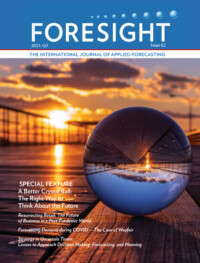Following is Editor Len Tashman's preview of the new issue of Foresight: The International Journal of Applied Forecasting.
 Preview of Foresight #62 (2021:Q3)
Preview of Foresight #62 (2021:Q3)
This 62nd issue of Foresight has been heavily “infected” by the COVID pandemic.
Stephan Kolassa’s book review of Resurrecting Retail by Doug Stephens raises the question of whether the COVID disruptions decisively shifted the entire game of retail – as the author contends – or merely accelerated existing trends at play in the industry.
George Monokroussos and colleagues at Wayfair detail the company’s fundamental changes in forecasting methodology to adapt to the uncertainty and pattern disruption caused by the pandemic. Wayfair developed a structured approach to forecast its business drivers on the basis of scenarios for how the pandemic could evolve.
Chris Turner offers a strategic perspective on how businesses can survive and thrive during periods of extreme volatility and instability. His four lenses urge organizations to carefully balance their desire for control of existing processes with the need to develop resilient processes that will enable growth and prosperity in the long run.
Forecasters are an integral part of charting the map for an uncertain future, understanding how the demands from decision makers will change, developing new capabilities, and demonstrating the value that forecasting can bring to strategy.
The feature section in this issue is entitled A Better Crystal Ball. In their article of that name in the journal Foreign Affairs, reprinted with permission here, J. Peter Scoblic and Philip Tetlock propose a synthesis of scenario forecasting – the creation of plausible futures – with probabilistic judgments about the likelihood of different scenarios.
Scenario planners maintain that there are so many possible futures that one can imagine them only in terms of plausibility, not probability. By contrast, forecasters believe it is possible to calculate the odds of possible outcomes, thereby transforming amorphous uncertainty into quantifiable risk. Because each method has its strengths, the optimal approach is to combine them.
Commentaries on the “better crystal ball” clarify the objectives of scenario development, examine the distinction between risk and uncertainty, and lay out important obstacles to the attachment of probabilities to uncertain events. [Commentaries provided by Paul Goodwin, Steve Morlidge, Roy Batchelor, Stefan de Kok, Mike Trembley, and Robert Fildes.] The Scoblic-Tetlock response to the commentaries will be printed in the next issue of Foresight, 2021:Q4.
Also upcoming in the Q4 issue are:
- a tutorial on random forests, an ensemble method of classification and forecasting that has achieved wide attention in data science;
- a perspective on “one-number forecasting” and whether this is the best way to achieve one mindset in an organization;
- an assessment of forecasting performance that goes “beyond forecast errors” to encompass considerations of utility and cost;
- an introduction to possibility theory and how possibility distributions can be applied to forecasts in the absence of historical data;
- a review article assessing the impacts of COVID-19 on the economy and strategic environment of the United States.
